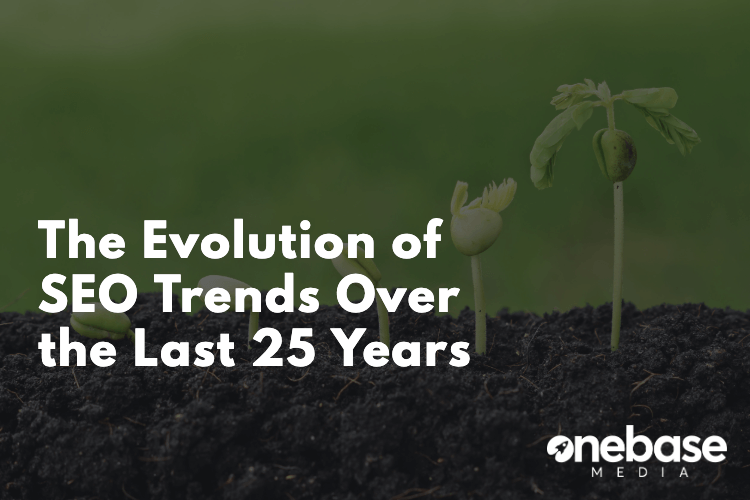
As you can imagine in the last 25 years SEO has grown and changed dramatically to get to the finely tuned algorithms it has now.
But as the first signs of SEO emerged for people, alongside the dawn of the internet, few people would have anticipated the impact that it has on daily life such a short time after.
After just a quarter century, SEO has grown from the simplicity of a single-celled organism into an adaptive structure used to share valuable and relevant information.
For users today, SEO creates a platform in which they can get targeted, personalised and engaging information from.
You can only predict what the future of SEO is going to be, but to be able to do that you need to understand the trends of SEO over the last 25 years that it has been around.
1991-2002: The First Signs of Life.
On the 6th August 1991 Tim Berners-Lee launched the world’s first website, which by the way is still live today. Once this first website launched many others followed over the years. As websites crowded the Internet, the very first search engine felt a need for structure and accessibility, so search platforms like Excite revolutionised how information was catalogued in 1993. Excite did this by making it easier to find information by sorting results in terms of the keywords found within the content and back-end optimisation. So shortly afterwards, major competitors like Yahoo (1994) and Google (1997) entered the scene to improve and simplify how data is indexed and delivered. In the primary stages of SEO, there wasn’t any limitations, therefore marketers could do the following to generate high rankings in search results;- Keyword stuffing
- Excessive tagging
- (Often spammy) Backlinks
2003 – 2005: The Early Days.
Unethical optimisation tactics were taken seriously by Google, as they took charge on developing a more level playing field for brands and content producers to earn more rankings. This period brought many updates that would penalise bad linking practices and keyword stuffing to improve indexing. To continue their efforts in improving the value and relevancy of results, search engines offered a personalised search which was based on user history. In addition to this, the birth of local SEO would help connect users with valuable information near them such as;- Maps
- Locations
- Store Hours
- Mobile Results
2006 – 2009: At the Middle Ages.
The recent trends and user behaviour started to influence the need for a more reactive search experience. Therefore, this period brought in features like Google’s Universal Search, to offer more engaging content in search results such as;- News
- Images
- Video
2010 – 2012: The Enlightenment.
So, this era saw a massive change in SEO occur, forcing brands to earn rankings through quality, user focused content or they were to face penalties in their search result rankings. Major updates from Google enforced stricter regulations on the following;- Keywords
- Content quality
- Over optimisation
2013 – Present: In the Modern Ages.
So today, we find ourselves at a crossroad, there is an apparent struggle between personalisation and privacy. As major search and social powerhouses develop a digital environment that’s optimised around user intent, we have started to hear users cry for security and a decrease in invasive marketing tactics. Brands like Google use user data to develop their own digital presence, they did this by personalising results based on history, location and device. This same data is usually hidden from marketers and creates a catch-22 that requires a different approach one that is more creative to generate engagement through content optimisation. Furthermore, this era of SEO brought on yet another shift towards relevant content and accessibility with mobile and local searches. Today, websites that lack mobile optimisation or responsive design have unfortunately lost search visibility in Google. Optimisation for device and user intent and segmented content offers the greatest opportunity to increase search authority by building links, leveraging long-tail keywords and building relationships. Finally, today the internet demands personalisation and quality content to be competitive.What’s Going to Happen in the Future?
To most of our disappointment there are only a few things we know for certain about the future of SEO, but we can certainly expect to see more niche and focused experiences focused around users and high quality, unique content. Users want search results to offer an instant contextual understanding with minimal effort, smart tech and wearable gadgets show a trend in being constantly connected and predictive content solutions. We can tell you that SEO will continue to evolve and fill this need, possibly by getting data from external platforms to personalise search results and offer additional value to users. You can prepare your brand for this change by optimising new kinds of content, for example in-app content, based around how users search. Drive your exposure and engagement with concise and direct content which is optimised for user intent. Most likely, SEO will be fully integrated into all assets that Google can access and should be a first thought for any brand creating online content. And marketers will need to develop a strong consistent brand presence, to keep their rankings high, across all digital channels and maintain a social influence. Start to experiment with visual content media, as trends are showing a preference among users that search engines will soon start to follow, and make sure you content is accessible from anywhere and is also optimised for local, mobile and even voice-enabled searches. Start to take educated risks, your creativity and curiosity will be rewarded! Start thinking in the perspective of the user if you are not already doing so, as that will help you create content that search engines will rank highly! Don’t cut corners, the trends over the last 25 years have shown the importance of ethical optimisation techniques and building relationships with users and content creators. Not only this, but as SEO continues to evolve you can expect to see more regulations and penalties for any questionable practices.
Speak to an expert
Got a quick question about your marketing? Or you want to run through the details of your next big project. We can help.
Speak to one of our experts today on 01702 668207 or send us a message.
